2023年中考英语语法复习 动词的时态课件(共50张PPT)
文档属性
| 名称 | 2023年中考英语语法复习 动词的时态课件(共50张PPT) | 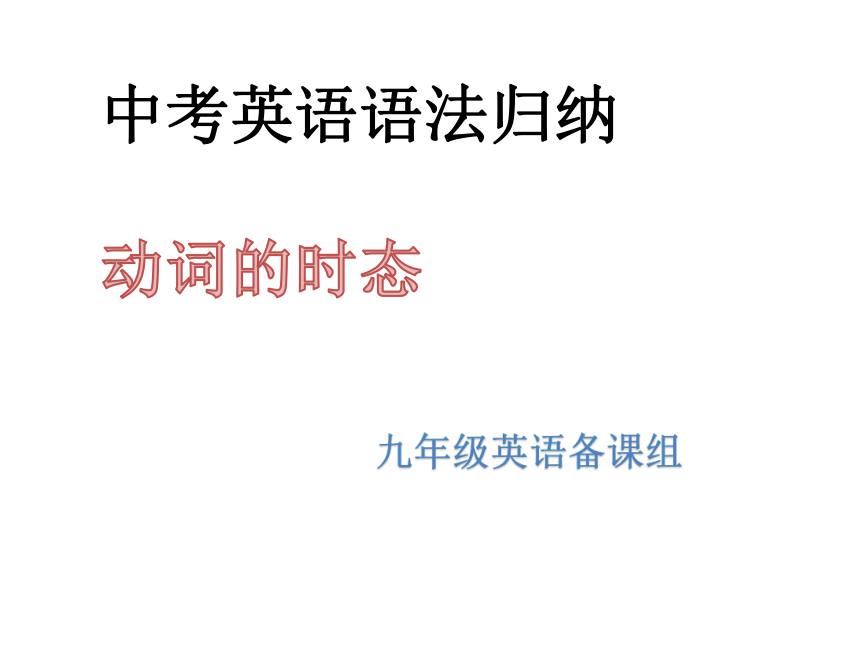 | |
| 格式 | zip | ||
| 文件大小 | 132.4KB | ||
| 资源类型 | 教案 | ||
| 版本资源 | 人教新目标(Go for it)版 | ||
| 科目 | 英语 | ||
| 更新时间 | 2022-07-28 08:46:26 | ||
图片预览

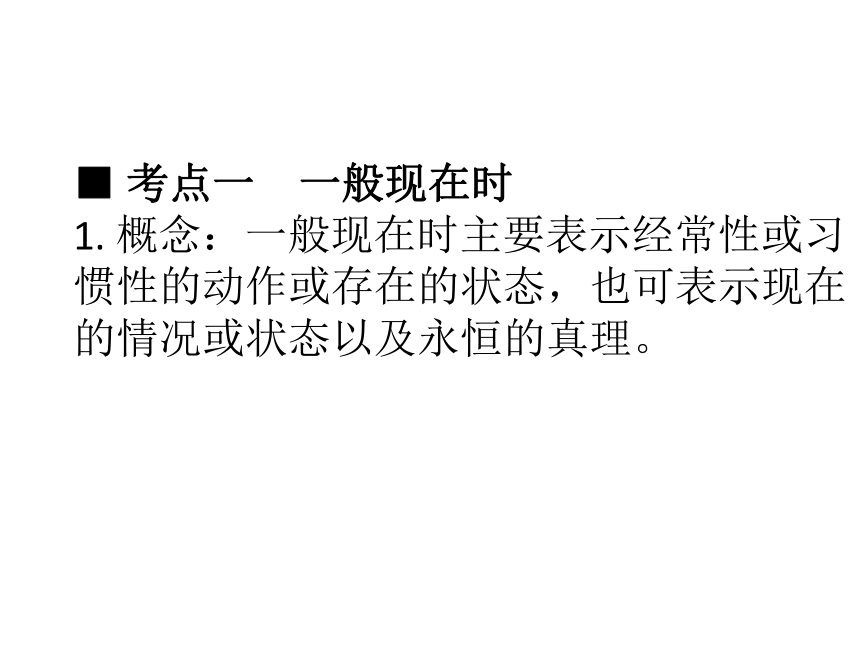
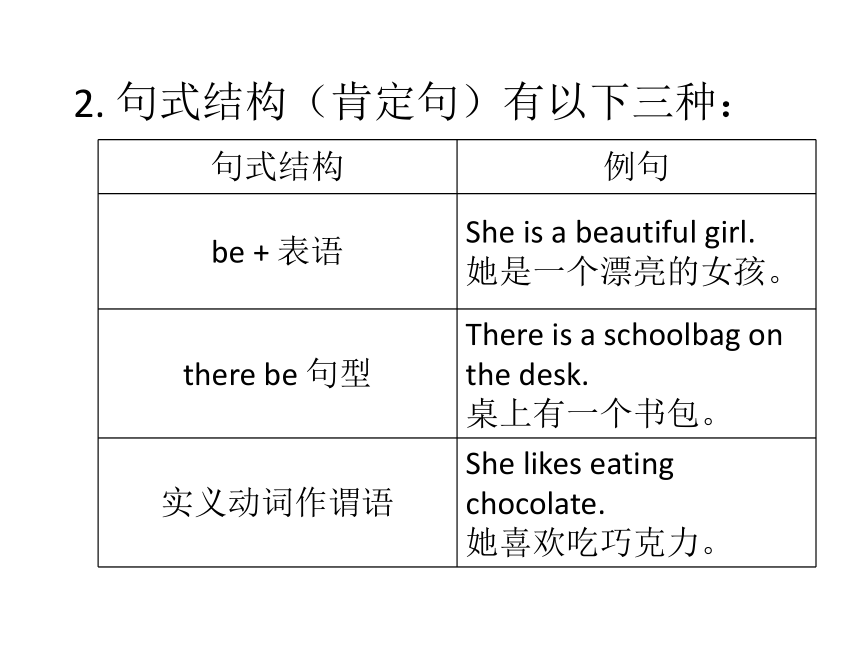
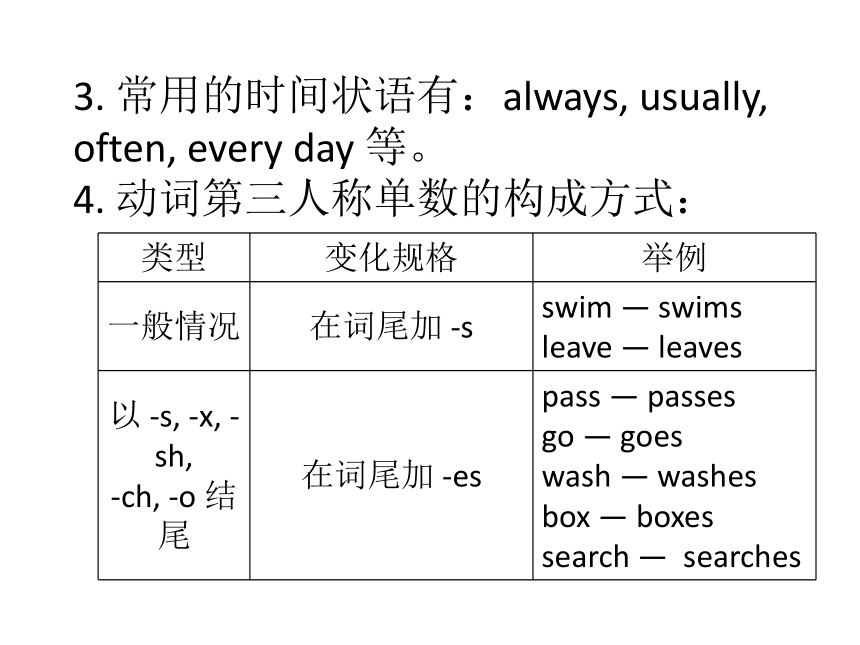

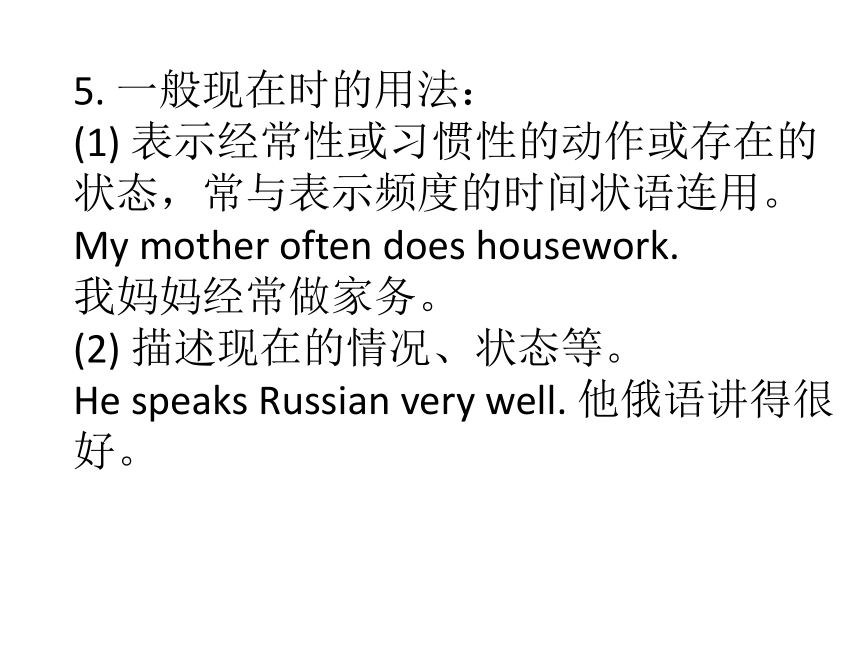
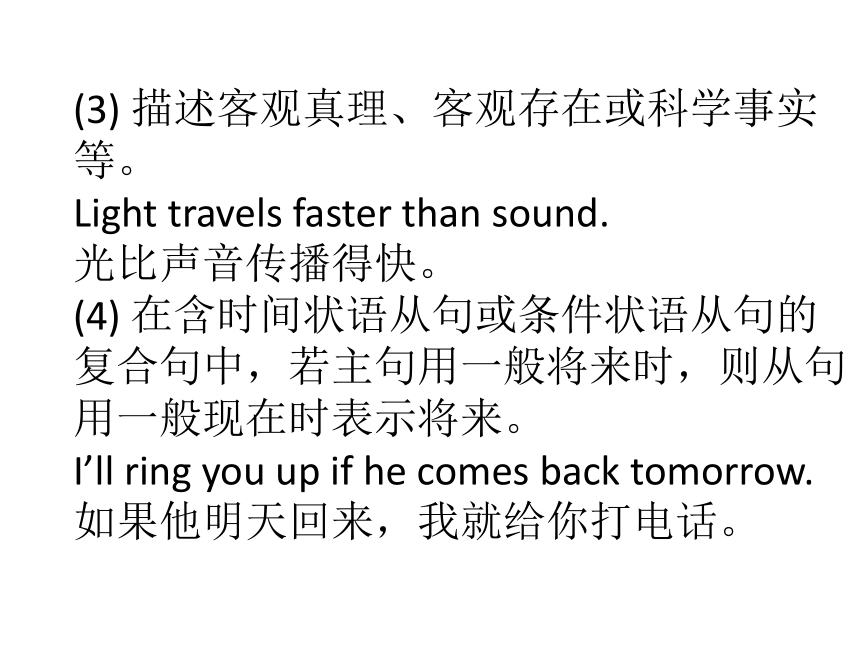
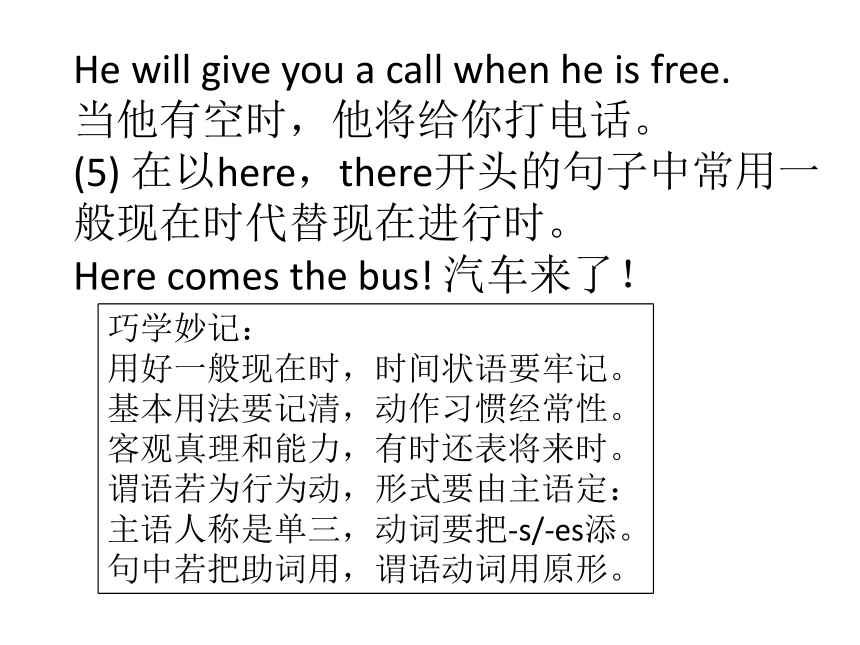
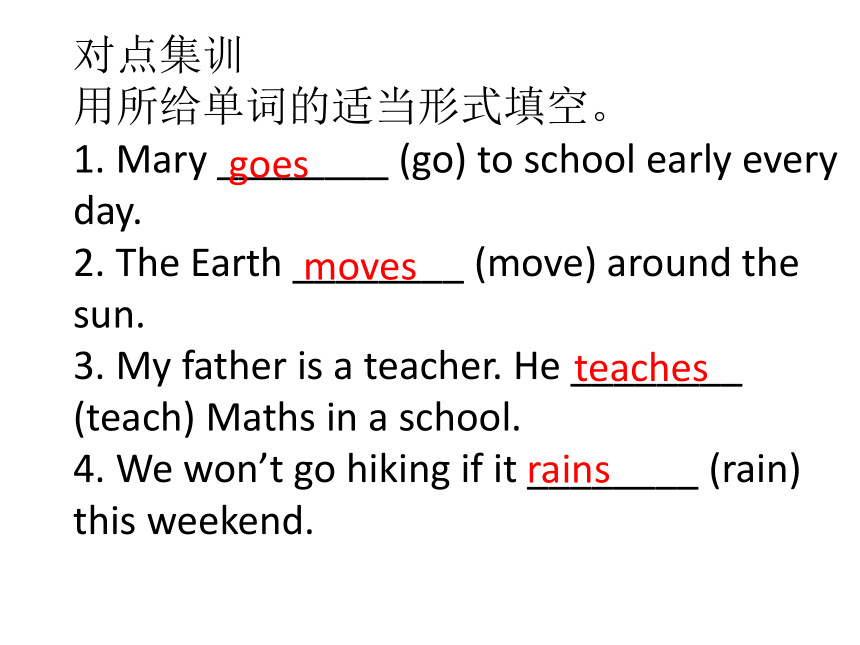
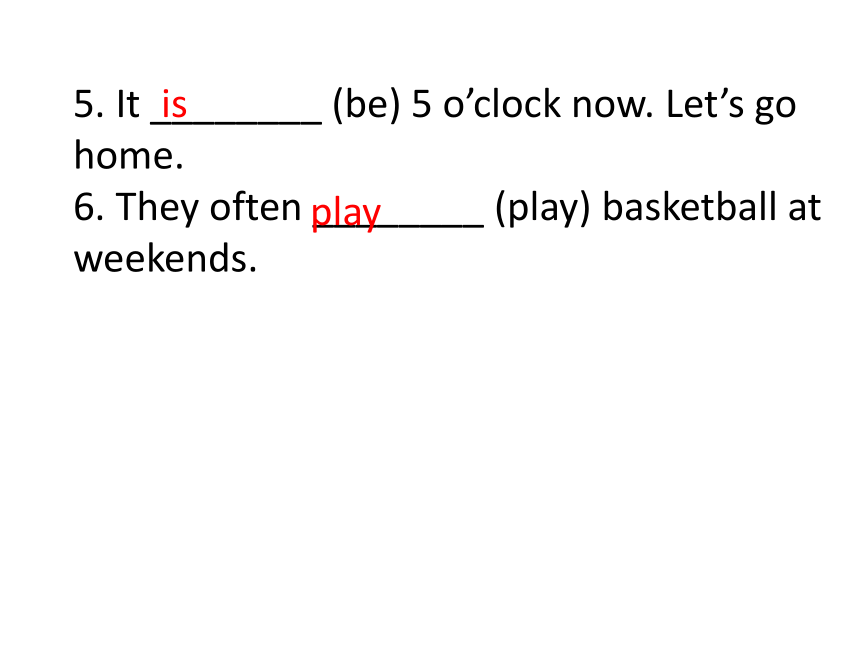
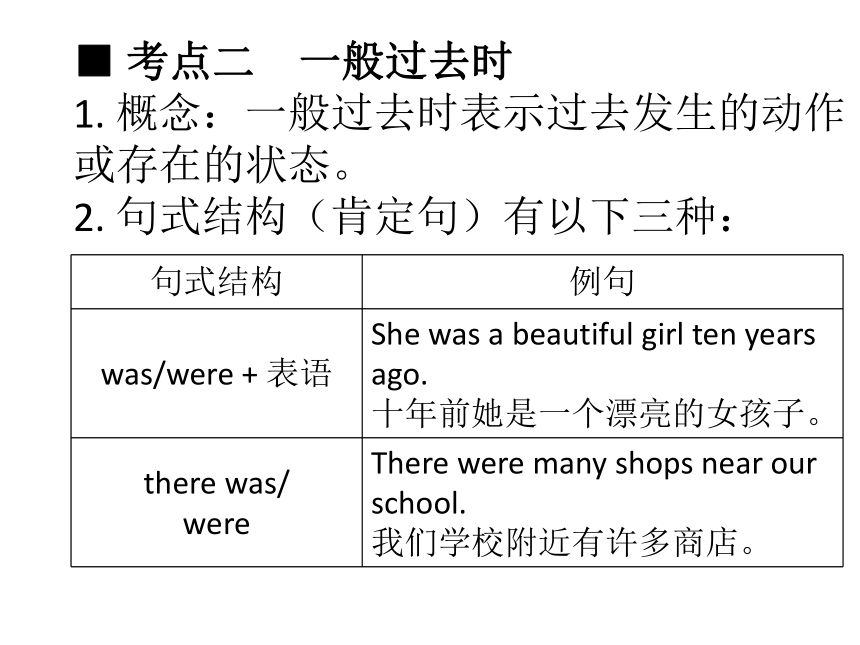
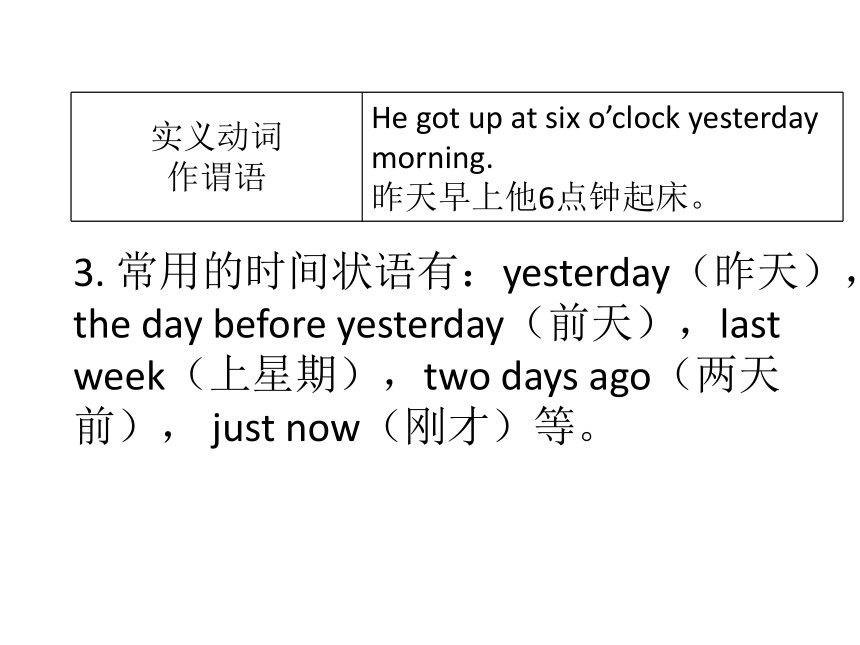
文档简介
(共50张PPT)
中考英语语法归纳
动词的时态
九年级英语备课组
■ 考点一 一般现在时
1. 概念:一般现在时主要表示经常性或习惯性的动作或存在的状态,也可表示现在的情况或状态以及永恒的真理。
2. 句式结构(肯定句)有以下三种:
句式结构 例句
be + 表语 She is a beautiful girl.
她是一个漂亮的女孩。
there be 句型 There is a schoolbag on the desk.
桌上有一个书包。
实义动词作谓语 She likes eating chocolate.
她喜欢吃巧克力。
3. 常用的时间状语有:always, usually, often, every day 等。
4. 动词第三人称单数的构成方式:
类型 变化规格 举例
一般情况 在词尾加 -s swim — swims
leave — leaves
以 -s, -x, -sh, -ch, -o 结尾 在词尾加 -es pass — passes
go — goes
wash — washes
box — boxes
search — searches
以“辅音字母 + y”结尾 变 y 为 i 再加 -es study — studies
carry — carries
特殊情况 不规则变化 has – have
5. 一般现在时的用法:
(1) 表示经常性或习惯性的动作或存在的状态,常与表示频度的时间状语连用。
My mother often does housework.
我妈妈经常做家务。
(2) 描述现在的情况、状态等。
He speaks Russian very well. 他俄语讲得很好。
(3) 描述客观真理、客观存在或科学事实等。
Light travels faster than sound.
光比声音传播得快。
(4) 在含时间状语从句或条件状语从句的复合句中,若主句用一般将来时,则从句用一般现在时表示将来。
I’ll ring you up if he comes back tomorrow.
如果他明天回来,我就给你打电话。
He will give you a call when he is free.
当他有空时,他将给你打电话。
(5) 在以here,there开头的句子中常用一般现在时代替现在进行时。
Here comes the bus! 汽车来了!
巧学妙记:
用好一般现在时,时间状语要牢记。
基本用法要记清,动作习惯经常性。
客观真理和能力,有时还表将来时。
谓语若为行为动,形式要由主语定:
主语人称是单三,动词要把-s/-es添。
句中若把助词用,谓语动词用原形。
对点集训
用所给单词的适当形式填空。
1. Mary ________ (go) to school early every day.
2. The Earth ________ (move) around the sun.
3. My father is a teacher. He ________ (teach) Maths in a school.
4. We won’t go hiking if it ________ (rain) this weekend.
goes
moves
teaches
rains
5. It ________ (be) 5 o’clock now. Let’s go home.
6. They often ________ (play) basketball at weekends.
is
play
■ 考点二 一般过去时
1. 概念:一般过去时表示过去发生的动作或存在的状态。
2. 句式结构(肯定句)有以下三种:
句式结构 例句
was/were + 表语 She was a beautiful girl ten years ago.
十年前她是一个漂亮的女孩子。
there was/ were There were many shops near our school.
我们学校附近有许多商店。
3. 常用的时间状语有:yesterday(昨天),the day before yesterday(前天),last week(上星期),two days ago(两天前), just now(刚才)等。
实义动词 作谓语 He got up at six o’clock yesterday morning.
昨天早上他6点钟起床。
4. 动词过去式的构成方式:
类型 变化规格 举例
一般情况 在词尾加 -ed plant — planted
play — played
以 e 结尾 加 -d live — lived
change — changed
以“辅音字母 + y”结尾 改y为i 再加 -ed carry — carried
study — studied
以重读闭音节结尾,且末尾只有一个辅音字母 双写这个辅音字母,再加 -ed stop — stopped
plan — planned
5. 一般过去时的用法:
(1) 表示过去发生或过去经常发生的动作或存在的状态。
He visited the Great Wall yesterday.
昨天他游览了长城。
(2) 用于虚拟条件句中,表示与现在事实相反的情况。be 动词要用 were。
If I were you, I would take a small present.
如果我是你的话,我就带上一件小礼物。
巧学妙记:
动词一般过去时,表示过去发生事;
be 用 was 或用 were, have、 has 变 had;
谓语动词过去式,过去时间作标志;
一般动词加 -ed,若是特殊得硬记。
否定句很简单,主语之后 didn’t 添;
疑问句也不难,did 放在主语前;
如果谓语之前有 did,谓语动词需还原;
动词若是 was、 were, 否定就把 not 添。
对点集训
用所给单词的适当形式填空。
1. I ____________ (meet) an old friend on my way to school yesterday.
2. A man ____________ (stop) his car here a few minutes ago.
3. Betty often ____________ (come) to see us last year.
4. They once ____________ (study) in the same university.
met
stopped
came
studied
5. He ____________ (do not) go to the party because he was badly ill.
6. If I ____________ (have) the money, I’d buy a car.
didn’t
had
■ 考点三 一般将来时
1. 概念:一般将来时表示将来要发生的动作或存在的状态。
2. 句式结构(肯定句)有以下三种:
句式结构 例句
will/shall + 动词原形 They will have a good time.
他们将会玩得很愉快。
be going to + 动词原形 We are going to take an exam.
我们将要参加一个考试。
现在进行时 表将来 The bus is coming.
公共汽车要来了。
3. 常用的时间状语有:tomorrow, the day after tomorrow, in two hours, soon, in the future, next week/year等。
4. 一般将来时的用法:
(1) 表示将要发生的动作或存在的状态。
We are going to have a meeting to discuss the plan.
我们打算开会讨论这个计划。
She will reach here at five o’clock this afternoon by bus.
今天下午五点她将乘公共汽车到达这里。
(2) be going to 表示根据主观判断将来肯定发生的事情,will 表示客观上将来势必发生的事情。
Look at the dark clouds. It’s going to rain.
看那乌云,看来马上要下雨了。
He will be twenty years old next year.
明年他就要20岁了。
巧学妙记:
一般将来时,将来发生事。
谓语不一般,will 加动原。
要变疑问句,will 放在主语前。
否定句,也不难,will 后面 not 添。
对点集训
用所给单词的适当形式填空。
1. —____________ we ____________ (meet) at 8 o’clock next Sunday morning
—I ____________ (be not) free then. Let’s make it another day.
2. As you know, Andy ____________ (leave) for America soon.
3. If those wild animals can’t find enough food, they ____________ (die).
Shall meet
is leaving
will die
won’t be
4. They have gone to London. They ____________ (come) back in a week.
5. What are you ____________ (go) to do tonight
6. Robots ____________ (do) more heavy work for us in the future.
will come
going
will do
■ 考点四 现在进行时
1. 概念:现在进行时表示现在正在进行的动作。
2. 句式结构:主语 + am (is, are) + 现在分词+其他
3. 常用的时态标志词有:now, at the moment, look, listen 等。
注意:
某些表示感觉、愿望、状态等的动词,如 hope, want, smell, hear, see, like, have, know 等一般不用于进行时。如不能说:I am wanting to go to the zoo.
4. 现在分词的构成方式:
类型 变化规格 举例
一般情况 直接加 -ing play — playing
read — reading
以不发音的 e 结尾 去 e 加 -ing live — living
write — writing
以重读闭音节结尾,且末尾只有一个辅音字母 双写词尾的辅音字母再加 -ing put — putting
sit — sitting
以 ie 结尾 改 ie 为 y 再加 -ing die — dying
lie — lying
5. 现在进行时的用法:
(1) 表示目前正在进行的动作。
He is reading a book. 他正在看书。
(2) 与always,usually,forever 等词连用,表示说话者的赞扬、厌恶或不满等情绪。
He is always helping others. 他总是帮助别人。
(3) 一些表示位置移动的动词,如 go,come,leave,start,begin,arrive 等,常用现在进行时表示即将发生的动作。
He is leaving for Shanghai tomorrow.
明天他将前往上海。
巧学妙记:
主语在句首,am, is, are 跟在后,
现在分词跟着走,其他成分不可丢。
表示动作正进行,句中 now 时间定。
一般疑问句,be 提到前面去。
否定句式也简单,be 后只把 not 添。
对点集训
用所给单词的适当形式填空。
1. Look! Sam ____________ (watch) TV happily on the sofa.
2. Don’t talk on the phone when you ___________ (drive).
3. Be quiet! The other students ____________ (sleep).
4. Uncle Wang’s birthday ____________ (come) soon. I’ll buy a present for him.
is watching
are driving
are sleeping
is coming
5. My brother ____________ (wash) his car in the garden now.
6. Someone ____________ (knock) at the door. Can you open it
is washing
is knocking
■ 考点五 现在完成时
1. 概念:现在完成时表示过去发生的动作对现在造成的影响或产生的结果。还表示动作从过去某时开始,一直持续到现在,并有可能持续下去。
2. 句式结构:主语 + have/has + 过去分词+其他
3. 现在完成时的用法和常用的时间状语:
(1) 表示过去发生的动作对现在造成的影响或产生的结果,常与 already, yet, ever 等连用。
She has already finished the work.
她已经完成了工作。
(2) 表示动作从过去某时开始一直持续到现在,并有可能持续下去,常与“for + 时间段”或“since + 过去的时间点或一般过去时的句子”连用,此时句中的动词必须是延续性动词。
He has studied English since 10 years ago./He has studied English for ten years.
他学英语已经10年了。
巧学妙记:
学习现在完成时,谓语结构要牢记:have/has + 过分。
主要用法有两个:过去的动作对现在的影响或结果,just, already 常用着;
过去的动作或状态,一直持续到现在,for, since 把时间带。
对点集训
用所给单词的适当形式填空。
1. Philip ____________ (go) to New Zealand. He’ll be back in three days.
2. Monica, you ____________ (pass) the exam! Congratulations!
3. He is an old worker in this factory. He _________ (work) here for 20 years already.
4. Up to now, I ____________ (be) to Paris twice.
has gone
have passed
has worked
have been
5. Sorry, I ____________ (not finish) my homework yet. So I can’t play with you.
6. Miss Lee ____________ (do) a lot of work for the poor area since 2013.
haven’t finished
has done
■ 考点六 过去完成时
1. 概念:表示到过去某时为止或在过去某时之前已经发生或完成的动作,即“过去的过去”。如图:
…………|…………|…………|…………→
过去的过去 过去 现在
2. 句式结构:主语 + had + 过去分词 + 其他
3. 常用的时间状语:by the end of last term, by then 以及 when, after 等引导的时间状语从句。
4. 过去完成时的用法:
(1) 表示在过去某一时间之前已经发生或完成的动作,它表示动作发生在“过去的过去”。
By the time we arrived, the meeting had already begun.
当我们到达时,会议已经开始了。
(2) 用在 said, told, knew, heard 等动词后的宾语从句中。
She said (that) she had never been to Paris.
她说她从没有去过巴黎。
(3) 用在含 when, after, before 等引导的状语从句的复合句中。
When the police arrived, the thieves had run away.
当警察到的时候,小偷们已经逃跑了。
对点集训
用所给单词的适当形式填空。
1. Tom said he ____________ (learn) a little English before.
2. He was told that Mary ____________ (make) much progress since she went there.
3. She ____________ (teach) in a school before she came here.
4. By the time I was eight, I ____________ (start) playing the piano.
had learnt
had made
had taught
had started
5. I found your iPhone Xs after you ____________ (leave) the house.
6. Amy ____________ (know) the bad news. That was why she was so sad.
had left
had known
■ 考点七 过去将来时
1. 概念:表示在过去看来将要发生的动作或存在的状态。
2. 相对于一般将来时而言,其句式结构有以下三种:
(1) would/should + 动词原形
(2) was/were going to + 动词原形
(3) was/were doing 进行时态表将来
3. 过去将来时的用法:
(1) 在叙述过去的事情或事情发生的经过时,用过去将来时表示在当时看来将会发生的事。
It was May 30th. Mike was going to play basketball with his friend, so he decided to call his friend first.
那是5月30号,迈克打算和朋友一起打篮球,于是他决定先给朋友打电话。
(2) 用于主句为一般过去时的宾语从句中,表示将要发生的事情或曾经打算要做的事情。
He asked when the meeting would end.
他问会议何时结束。
对点集训
用所给单词的适当形式填空。
1. Arnold knew he ____________ (be) tired the next day.
2. They told me that they ____________ (be) going to work in Chengdu.
3. We didn’t know whether he ____________ (accept) the present or not.
4. She ____________ (be) going to see us, but she was too busy.
would be
were
would accept
was
5. Last week he promised that he ____________ (come), but he hasn’t arrived until now.
6. He said they ____________ (have) a school trip the next weekend.
would come
would have
■ 考点八 过去进行时
1. 概念:表示在过去某个时刻或某段时间正在进行的动作。
2. 句式结构:主语 + was (were) + 现在分词+其他
3. 常用的时间状语有:at nine o’clock last night(昨天晚上九点),at that time(那时),at that moment(当时),this time yesterday(昨天的这个时候),from 8:00 to 9:00 last night(昨晚的八点到九点)以及 when,while 引导的时间状语从句等。
4. 过去进行时的用法:
(1) 表示过去某一时刻正在进行的动作。
I was watering my flowers at nine yesterday morning.
昨天上午九点我在给花儿浇水。
(2) 表示过去某一段时间正在进行的动作。
What were you doing from 8:00 to 9:00 last night
昨晚 8:00 到 9:00 你在干什么?
拓展:
动词 come, go, leave, start, begin, arrive 等常用过去进行时表示从过去某时看将要发生的动作。
He said he was leaving for Beijing next week.
他说他下个星期要动身去北京。
John said that he was going to London with his father.
约翰说他要和他父亲到伦敦去。
对点集训
用所给单词的适当形式填空。
1. I was watching TV while my mum ____________ (cook).
2. He ____________ (listen) to the radio at that moment.
3. Millie ____________ (draw) a picture when Mr Green came in.
4. We ____________ (work) from two to six yesterday afternoon.
was cooking
was listening
was drawing
were working
5. Tom ____________ (play) computer games when his mother got home.
6. They ____________ (read) books in the room at this time yesterday.
was playing
were reading
中考英语语法归纳
动词的时态
九年级英语备课组
■ 考点一 一般现在时
1. 概念:一般现在时主要表示经常性或习惯性的动作或存在的状态,也可表示现在的情况或状态以及永恒的真理。
2. 句式结构(肯定句)有以下三种:
句式结构 例句
be + 表语 She is a beautiful girl.
她是一个漂亮的女孩。
there be 句型 There is a schoolbag on the desk.
桌上有一个书包。
实义动词作谓语 She likes eating chocolate.
她喜欢吃巧克力。
3. 常用的时间状语有:always, usually, often, every day 等。
4. 动词第三人称单数的构成方式:
类型 变化规格 举例
一般情况 在词尾加 -s swim — swims
leave — leaves
以 -s, -x, -sh, -ch, -o 结尾 在词尾加 -es pass — passes
go — goes
wash — washes
box — boxes
search — searches
以“辅音字母 + y”结尾 变 y 为 i 再加 -es study — studies
carry — carries
特殊情况 不规则变化 has – have
5. 一般现在时的用法:
(1) 表示经常性或习惯性的动作或存在的状态,常与表示频度的时间状语连用。
My mother often does housework.
我妈妈经常做家务。
(2) 描述现在的情况、状态等。
He speaks Russian very well. 他俄语讲得很好。
(3) 描述客观真理、客观存在或科学事实等。
Light travels faster than sound.
光比声音传播得快。
(4) 在含时间状语从句或条件状语从句的复合句中,若主句用一般将来时,则从句用一般现在时表示将来。
I’ll ring you up if he comes back tomorrow.
如果他明天回来,我就给你打电话。
He will give you a call when he is free.
当他有空时,他将给你打电话。
(5) 在以here,there开头的句子中常用一般现在时代替现在进行时。
Here comes the bus! 汽车来了!
巧学妙记:
用好一般现在时,时间状语要牢记。
基本用法要记清,动作习惯经常性。
客观真理和能力,有时还表将来时。
谓语若为行为动,形式要由主语定:
主语人称是单三,动词要把-s/-es添。
句中若把助词用,谓语动词用原形。
对点集训
用所给单词的适当形式填空。
1. Mary ________ (go) to school early every day.
2. The Earth ________ (move) around the sun.
3. My father is a teacher. He ________ (teach) Maths in a school.
4. We won’t go hiking if it ________ (rain) this weekend.
goes
moves
teaches
rains
5. It ________ (be) 5 o’clock now. Let’s go home.
6. They often ________ (play) basketball at weekends.
is
play
■ 考点二 一般过去时
1. 概念:一般过去时表示过去发生的动作或存在的状态。
2. 句式结构(肯定句)有以下三种:
句式结构 例句
was/were + 表语 She was a beautiful girl ten years ago.
十年前她是一个漂亮的女孩子。
there was/ were There were many shops near our school.
我们学校附近有许多商店。
3. 常用的时间状语有:yesterday(昨天),the day before yesterday(前天),last week(上星期),two days ago(两天前), just now(刚才)等。
实义动词 作谓语 He got up at six o’clock yesterday morning.
昨天早上他6点钟起床。
4. 动词过去式的构成方式:
类型 变化规格 举例
一般情况 在词尾加 -ed plant — planted
play — played
以 e 结尾 加 -d live — lived
change — changed
以“辅音字母 + y”结尾 改y为i 再加 -ed carry — carried
study — studied
以重读闭音节结尾,且末尾只有一个辅音字母 双写这个辅音字母,再加 -ed stop — stopped
plan — planned
5. 一般过去时的用法:
(1) 表示过去发生或过去经常发生的动作或存在的状态。
He visited the Great Wall yesterday.
昨天他游览了长城。
(2) 用于虚拟条件句中,表示与现在事实相反的情况。be 动词要用 were。
If I were you, I would take a small present.
如果我是你的话,我就带上一件小礼物。
巧学妙记:
动词一般过去时,表示过去发生事;
be 用 was 或用 were, have、 has 变 had;
谓语动词过去式,过去时间作标志;
一般动词加 -ed,若是特殊得硬记。
否定句很简单,主语之后 didn’t 添;
疑问句也不难,did 放在主语前;
如果谓语之前有 did,谓语动词需还原;
动词若是 was、 were, 否定就把 not 添。
对点集训
用所给单词的适当形式填空。
1. I ____________ (meet) an old friend on my way to school yesterday.
2. A man ____________ (stop) his car here a few minutes ago.
3. Betty often ____________ (come) to see us last year.
4. They once ____________ (study) in the same university.
met
stopped
came
studied
5. He ____________ (do not) go to the party because he was badly ill.
6. If I ____________ (have) the money, I’d buy a car.
didn’t
had
■ 考点三 一般将来时
1. 概念:一般将来时表示将来要发生的动作或存在的状态。
2. 句式结构(肯定句)有以下三种:
句式结构 例句
will/shall + 动词原形 They will have a good time.
他们将会玩得很愉快。
be going to + 动词原形 We are going to take an exam.
我们将要参加一个考试。
现在进行时 表将来 The bus is coming.
公共汽车要来了。
3. 常用的时间状语有:tomorrow, the day after tomorrow, in two hours, soon, in the future, next week/year等。
4. 一般将来时的用法:
(1) 表示将要发生的动作或存在的状态。
We are going to have a meeting to discuss the plan.
我们打算开会讨论这个计划。
She will reach here at five o’clock this afternoon by bus.
今天下午五点她将乘公共汽车到达这里。
(2) be going to 表示根据主观判断将来肯定发生的事情,will 表示客观上将来势必发生的事情。
Look at the dark clouds. It’s going to rain.
看那乌云,看来马上要下雨了。
He will be twenty years old next year.
明年他就要20岁了。
巧学妙记:
一般将来时,将来发生事。
谓语不一般,will 加动原。
要变疑问句,will 放在主语前。
否定句,也不难,will 后面 not 添。
对点集训
用所给单词的适当形式填空。
1. —____________ we ____________ (meet) at 8 o’clock next Sunday morning
—I ____________ (be not) free then. Let’s make it another day.
2. As you know, Andy ____________ (leave) for America soon.
3. If those wild animals can’t find enough food, they ____________ (die).
Shall meet
is leaving
will die
won’t be
4. They have gone to London. They ____________ (come) back in a week.
5. What are you ____________ (go) to do tonight
6. Robots ____________ (do) more heavy work for us in the future.
will come
going
will do
■ 考点四 现在进行时
1. 概念:现在进行时表示现在正在进行的动作。
2. 句式结构:主语 + am (is, are) + 现在分词+其他
3. 常用的时态标志词有:now, at the moment, look, listen 等。
注意:
某些表示感觉、愿望、状态等的动词,如 hope, want, smell, hear, see, like, have, know 等一般不用于进行时。如不能说:I am wanting to go to the zoo.
4. 现在分词的构成方式:
类型 变化规格 举例
一般情况 直接加 -ing play — playing
read — reading
以不发音的 e 结尾 去 e 加 -ing live — living
write — writing
以重读闭音节结尾,且末尾只有一个辅音字母 双写词尾的辅音字母再加 -ing put — putting
sit — sitting
以 ie 结尾 改 ie 为 y 再加 -ing die — dying
lie — lying
5. 现在进行时的用法:
(1) 表示目前正在进行的动作。
He is reading a book. 他正在看书。
(2) 与always,usually,forever 等词连用,表示说话者的赞扬、厌恶或不满等情绪。
He is always helping others. 他总是帮助别人。
(3) 一些表示位置移动的动词,如 go,come,leave,start,begin,arrive 等,常用现在进行时表示即将发生的动作。
He is leaving for Shanghai tomorrow.
明天他将前往上海。
巧学妙记:
主语在句首,am, is, are 跟在后,
现在分词跟着走,其他成分不可丢。
表示动作正进行,句中 now 时间定。
一般疑问句,be 提到前面去。
否定句式也简单,be 后只把 not 添。
对点集训
用所给单词的适当形式填空。
1. Look! Sam ____________ (watch) TV happily on the sofa.
2. Don’t talk on the phone when you ___________ (drive).
3. Be quiet! The other students ____________ (sleep).
4. Uncle Wang’s birthday ____________ (come) soon. I’ll buy a present for him.
is watching
are driving
are sleeping
is coming
5. My brother ____________ (wash) his car in the garden now.
6. Someone ____________ (knock) at the door. Can you open it
is washing
is knocking
■ 考点五 现在完成时
1. 概念:现在完成时表示过去发生的动作对现在造成的影响或产生的结果。还表示动作从过去某时开始,一直持续到现在,并有可能持续下去。
2. 句式结构:主语 + have/has + 过去分词+其他
3. 现在完成时的用法和常用的时间状语:
(1) 表示过去发生的动作对现在造成的影响或产生的结果,常与 already, yet, ever 等连用。
She has already finished the work.
她已经完成了工作。
(2) 表示动作从过去某时开始一直持续到现在,并有可能持续下去,常与“for + 时间段”或“since + 过去的时间点或一般过去时的句子”连用,此时句中的动词必须是延续性动词。
He has studied English since 10 years ago./He has studied English for ten years.
他学英语已经10年了。
巧学妙记:
学习现在完成时,谓语结构要牢记:have/has + 过分。
主要用法有两个:过去的动作对现在的影响或结果,just, already 常用着;
过去的动作或状态,一直持续到现在,for, since 把时间带。
对点集训
用所给单词的适当形式填空。
1. Philip ____________ (go) to New Zealand. He’ll be back in three days.
2. Monica, you ____________ (pass) the exam! Congratulations!
3. He is an old worker in this factory. He _________ (work) here for 20 years already.
4. Up to now, I ____________ (be) to Paris twice.
has gone
have passed
has worked
have been
5. Sorry, I ____________ (not finish) my homework yet. So I can’t play with you.
6. Miss Lee ____________ (do) a lot of work for the poor area since 2013.
haven’t finished
has done
■ 考点六 过去完成时
1. 概念:表示到过去某时为止或在过去某时之前已经发生或完成的动作,即“过去的过去”。如图:
…………|…………|…………|…………→
过去的过去 过去 现在
2. 句式结构:主语 + had + 过去分词 + 其他
3. 常用的时间状语:by the end of last term, by then 以及 when, after 等引导的时间状语从句。
4. 过去完成时的用法:
(1) 表示在过去某一时间之前已经发生或完成的动作,它表示动作发生在“过去的过去”。
By the time we arrived, the meeting had already begun.
当我们到达时,会议已经开始了。
(2) 用在 said, told, knew, heard 等动词后的宾语从句中。
She said (that) she had never been to Paris.
她说她从没有去过巴黎。
(3) 用在含 when, after, before 等引导的状语从句的复合句中。
When the police arrived, the thieves had run away.
当警察到的时候,小偷们已经逃跑了。
对点集训
用所给单词的适当形式填空。
1. Tom said he ____________ (learn) a little English before.
2. He was told that Mary ____________ (make) much progress since she went there.
3. She ____________ (teach) in a school before she came here.
4. By the time I was eight, I ____________ (start) playing the piano.
had learnt
had made
had taught
had started
5. I found your iPhone Xs after you ____________ (leave) the house.
6. Amy ____________ (know) the bad news. That was why she was so sad.
had left
had known
■ 考点七 过去将来时
1. 概念:表示在过去看来将要发生的动作或存在的状态。
2. 相对于一般将来时而言,其句式结构有以下三种:
(1) would/should + 动词原形
(2) was/were going to + 动词原形
(3) was/were doing 进行时态表将来
3. 过去将来时的用法:
(1) 在叙述过去的事情或事情发生的经过时,用过去将来时表示在当时看来将会发生的事。
It was May 30th. Mike was going to play basketball with his friend, so he decided to call his friend first.
那是5月30号,迈克打算和朋友一起打篮球,于是他决定先给朋友打电话。
(2) 用于主句为一般过去时的宾语从句中,表示将要发生的事情或曾经打算要做的事情。
He asked when the meeting would end.
他问会议何时结束。
对点集训
用所给单词的适当形式填空。
1. Arnold knew he ____________ (be) tired the next day.
2. They told me that they ____________ (be) going to work in Chengdu.
3. We didn’t know whether he ____________ (accept) the present or not.
4. She ____________ (be) going to see us, but she was too busy.
would be
were
would accept
was
5. Last week he promised that he ____________ (come), but he hasn’t arrived until now.
6. He said they ____________ (have) a school trip the next weekend.
would come
would have
■ 考点八 过去进行时
1. 概念:表示在过去某个时刻或某段时间正在进行的动作。
2. 句式结构:主语 + was (were) + 现在分词+其他
3. 常用的时间状语有:at nine o’clock last night(昨天晚上九点),at that time(那时),at that moment(当时),this time yesterday(昨天的这个时候),from 8:00 to 9:00 last night(昨晚的八点到九点)以及 when,while 引导的时间状语从句等。
4. 过去进行时的用法:
(1) 表示过去某一时刻正在进行的动作。
I was watering my flowers at nine yesterday morning.
昨天上午九点我在给花儿浇水。
(2) 表示过去某一段时间正在进行的动作。
What were you doing from 8:00 to 9:00 last night
昨晚 8:00 到 9:00 你在干什么?
拓展:
动词 come, go, leave, start, begin, arrive 等常用过去进行时表示从过去某时看将要发生的动作。
He said he was leaving for Beijing next week.
他说他下个星期要动身去北京。
John said that he was going to London with his father.
约翰说他要和他父亲到伦敦去。
对点集训
用所给单词的适当形式填空。
1. I was watching TV while my mum ____________ (cook).
2. He ____________ (listen) to the radio at that moment.
3. Millie ____________ (draw) a picture when Mr Green came in.
4. We ____________ (work) from two to six yesterday afternoon.
was cooking
was listening
was drawing
were working
5. Tom ____________ (play) computer games when his mother got home.
6. They ____________ (read) books in the room at this time yesterday.
was playing
were reading
同课章节目录
- 词法
- 名词
- 动词和动词短语
- 动词语态
- 动词时态
- 助动词和情态动词
- 非谓语动词
- 冠词
- 代词
- 数词和量词
- 形容词副词及其比较等级
- 介词和介词短语
- 连词和感叹词
- 构词法
- 相似、相近词比较
- 句法
- 陈述句
- 一般疑问句和否定疑问句
- 特殊疑问句及选择疑问句
- 反意疑问句
- 存在句(There be句型)
- 宾语从句
- 定语从句
- 状语从句
- 主谓一致问题
- 简单句
- 并列句
- 复合句
- 主谓一致
- 主、表语从句
- 名词性从句
- 直接引语和间接引语
- 虚拟语气
- 感叹句
- 强调句
- 倒装句
- 祈使句
- 句子的成分
- 句子的分类
- 题型专区
- 单项选择部分
- 易错题
- 完形填空
- 阅读理解
- 词汇练习
- 听说训练
- 句型转换
- 补全对话
- 短文改错
- 翻译
- 书面表达
- 任务型阅读
- 语法填空
- 其他资料
